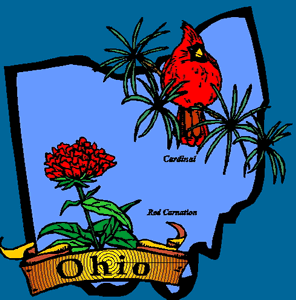


Geography and Landforms:
During the past two million years, glaciers have shaped and reshaped the surface of Ohio several times. These continental masses of ice affected as much as two-thirds of the state. Moving from the north and northwest, glaciers have scraped and flattened the landscape. Often more than a mile thick, they smoothed existing hills and filled valleys with enormous amounts of rocks, gravel, and smaller particles.
|
 History:
When European explorers first arrived in the area now known as Ohio in the late 1600s, they found Delaware, Shawnee, Wyandot, and Miami Indian tribes living there. Frenchman Rene-Robert Cavelier explored the Ohio region in 1670 and is believed to be the first white man to visit the area. In 1750, the Ohio Company of Virginia sent Christopher Gist to explore Ohio in preparation for the settlement of British colonists. Therefore, both the French and the British believed they held claim to Ohio. These disputes over land in North America started the French and Indian Wars, which ended in 1763 with the British in control of most land in North America. One of the provisions of the Treaty of Paris, which concluded the French and Indian War, was that the British would prohibit settlement of the areas west of the Alleghany Mountains, including Ohio. However, Europeans were hungry for land and resources. They continued to push their settlements further and further west in violation of the treaty. This continued to cause trouble with the native occupants of the land and was one of the issues that led to the Revolutionary War.
|
 Economy:
Ohio is located in the heart of the country's industrial region. More than 60 percent of all U.S. households live within 600 miles of Ohio. There is access to strategic waterways, and the state is well served by interstate highways. Ohio has the seventh largest state economy in the U.S., and ranks third in manufacturing gross state product. The state's factories lead the nation in the production of steel, rubber and plastics, and fabricated metals. Ohio is also a leader in the automotive industry.
|
 First Inhabitants:
The hunting and gathering peoples who originally discovered the Americas were called Paleo-Indians. They lived in Ohio in the last centuries of the Ice Age. They hunted now-extinct species of big game animals such as mammoth and mastodon. They also hunted deer and small game, fished, and gathered nuts and fruit when available. The earliest Paleo-Indian culture discovered in Ohio is the Clovis culture which occupied the area from around 9500--8000 BC. They are known as the Clovis culture because of the distinctive shape of their spear points. The culture probably was centered in present-day New Mexico and migrated eastward. In Ohio, they found important sources of flint for their weapons and tools.
|
Books Related To OhioAbsolutely Normal Chaos - Sharon Creech B is for Buckeye: An Ohio Alphabet - Bruce Langton Crooked River - Shelley Pearsall Crooked River - Shelley Pearsall Double Dutch - Sharon Draper Double Dutch - Sharon Draper Heaven - Angela Johnson North by Night: A Story of the Underground Railroad - Katherine Ayres Paperboy - Mary Kay Kroeger Time Pieces - Virginia Hamilton Weasel - Cynthia DeFelice |
Famous Citizens:
|
| Capital: | Columbus |
| Entered Union: | March 1, 1803 |
| Population: | 11,594,163 |
| Area | 44,825 |
| Bird | Cardinal |
| Flower | Scarlet Carnation |
| Nickname: | Buckeye State |
| Governor | John Kasich |
Places to Visit in Ohio: (Click the links to learn more.)
|



